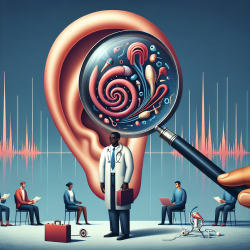Introduction
Noise-Induced Hearing Loss (NIHL) is a significant concern, affecting approximately 5% of the global population. It ranks as the second most common cause of sensorineural hearing loss, trailing only age-related hearing loss. The ramifications of NIHL are profound, impacting individuals physically, mentally, socially, and economically. This blog explores the findings from the research article "Noise-Induced Hearing Loss" and provides actionable insights for practitioners to enhance their skills in diagnosing, preventing, and managing NIHL.
Understanding NIHL
NIHL results from multifactorial damage to auditory structures due to exposure to loud sounds from occupational, environmental, or recreational sources. Historically recognized as a health issue since the Industrial Revolution, NIHL is often preventable through appropriate precautions, such as using hearing protection. The pathophysiology of NIHL involves genetic and environmental factors, with significant occupational contributions.
Key Findings from the Research
- Diagnosis and Screening: Diagnosis involves reviewing a patient’s history of noise exposure, audiograms, speech-in-noise test results, and measurements of distortion product otoacoustic emissions and auditory brainstem response.
- Prevention and Early Detection: Implementing educational and screening programs in routine primary care and specialty clinics is crucial for reducing the burden of NIHL.
- Pharmacological Treatments: Current research on pharmacological treatments includes anti-inflammatory, antioxidant, anti-excitatory, and anti-apoptotic agents. However, there is a low level of evidence for effective pharmacotherapeutic interventions.
- Future Directions: Future strategies should focus on personalized prevention and targeted treatment based on a holistic view of an individual’s occupation, genetics, and pathology.
Practical Applications for Practitioners
Practitioners can enhance their skills by incorporating the following strategies:
- Education and Awareness: Educate patients about the risks of noise exposure and the importance of using hearing protection devices.
- Regular Screenings: Conduct regular hearing screenings, especially for individuals in high-risk occupations, to detect early signs of NIHL.
- Stay Informed: Keep abreast of the latest research and developments in NIHL to provide informed care and advice to patients.
- Advocate for Policy Changes: Encourage the implementation of workplace noise regulations and advocate for policies that protect individuals from excessive noise exposure.
Conclusion
NIHL is a preventable condition with significant impacts on individuals and society. By understanding the research findings and implementing effective prevention and management strategies, practitioners can play a crucial role in reducing the incidence and impact of NIHL. For those interested in delving deeper into the research, the original paper offers comprehensive insights into the complexities of NIHL.
To read the original research paper, please follow this link: Noise-Induced Hearing Loss.










